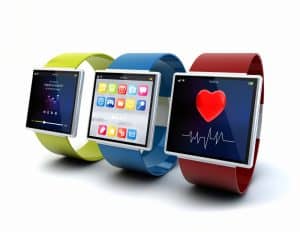
Smart wearable devices offer a wealth of data for analysis. But for the devices to be design and produced, critical engineering challenges must be addressed.
Imagine being assigned a 40mm x 40mm guardian angel. This may sound strange but is definitely true for R. Rajhans, a senior citizen living in India who was able to detect his irregular heart rhythms and receive timely medical attention because of the Apple Watch Series 5 gifted to him by his son. This is not an isolated incident; many such cases have been observed across the globe emphasizing the vital role of smart wearable tech in the near future.
Wearables such as activity trackers, smart medical devices, smartwatches, touch-enabled t-shirts, and more, have the ability to enhance our lifestyles by providing quality insights regarding one or more biometric parameters of our body which are being continuously monitored and processed by the sensors embedded within these smart devices. The wearable tech market size is expected to cross USD 100 billion by 2027 growing at an impressive 15.9 percentage CAGR. While many companies want to be a part of this growth story and grab a substantial share of this pie, designing them can be quite challenging and the bitter truth is only a select few will taste success and all others will fade into oblivion. In light of that, the following points should be taken into consideration while designing these wearables:
Smart Wearable Do’s
1. Low power and energy-efficient protocols: Smart wearable devices run on tiny batteries that are expected to last for days at a stretch without the need for charging them. Considering the fact that these devices are an integral part of a user’s daily life, enhancing battery life is of utmost importance. Designers should stress selecting PCB components with low run and sleep mode currents. In fact, many chip makers have designed ICs such as the ones belonging to PIC24FJ256GB412 family, which consume less than 100nA in sleep mode making them an apt choice for wearables. In addition to the components, energy-efficient wireless protocols should also be adopted wherever possible to reduce power consumption while transmitting data. These protocols can be industry-standard like BLE, Wi-Fi, and NFC or proprietaries like MiWi and SimpliciTI. Further minimization of power consumption can be achieved by reducing the frequency of data transfer outside the device and transmitting raw data to the cloud where the data can be stored, processed, and re-transmitted if needed.
2. Small form factor: No one wants a giant electronic device attached to their skin like glue all day long. In the domain of wearable design where every millimeter counts, miniaturization of the device is a must and special emphasis must be placed on this factor while choosing components like flexible batteries and modules with integrated antennas such as BMD-350. A highly compact and sleek design with a plethora of features is the ultimate choice of hardware engineering experts and enthusiasts.
3. Ensure security: Many people have cited privacy and security of the data as their biggest concern with wearables and it’s not difficult to see why that’s the case. We carry them wherever we go and these devices collect all the details of our daily lives, analyze and even store that in the cloud. A lot of this data is quite personal in nature because of which improving security in such devices is a non-negotiable element of wearable design. Using MCUs with inbuilt hardware crypto engines, implementing software protection models, utilizing better authentication techniques like passcodes or smart locks are a few ways in which the security of these wearables can be boosted.
4. Aesthetically appealing design: The smart wearable should appeal to all the senses of the user to ensure continued use for a long time. This includes an elegant and robust industrial design that is pleasant to our eyes and comfortable to wear(preferably hypoallergenic). Also, the device must boast of a visually appealing UI which focuses on key concepts like lightweight interactions and glanceability.
5. Choose the right product development partner: The design of any wearable device requires a multidisciplinary approach. A confluence of disciplines like electrical, firmware, software, mechanical and industrial design is needed to create a market-ready product. Very few companies can boast of having such eclectic teams but it is not a viable strategy for most. Hence, it is a necessity for many companies to get in touch with suitable product development partners who can collaborate with the in-house teams and take the product from the design to the mass-manufacturing stage. Having the right partners with prior experience in wearable tech can save a lot of time and money. Finding reliable partners with expertise in the different domains was an uphill task till a few years back, especially because of the lack of centralized platforms thereby causing delays. However, the companies can now get in touch with digital marketplaces which connects the project owners with multiple vendors on the same platform. They also enable the project owners to filter vendors based on their budget, location, and engineering services needed.
Engineering don’ts
1. Don’t expect the first iteration to be pitch-perfect: In fact, it may be nowhere close to it. Starting from a Proof of Concept (POC) to creating the Minimum Viable Product (MVP), there will be a lot of changes required in each design iteration. These changes will be shaped by the feedback obtained from the design team and some early users. It is crucial to move fast, set definite targets for each stage, and ensure that these targets are met in a timely fashion.
2. Don’t miss the details: Leaving minor details for the last adversely affects the time to market of the product. Designers should always have a broader picture in mind. There can be several issues with the mass manufacturing of wearable devices even if the preliminary design works just fine. Does the device need any complex manufacturing facility which only a few vendors can provide? How to reduce the design and supply chain costs? Is the design robust enough for use in a safety-critical environment? – Due attention should be paid to minutia like these. If there is a novel technology involved, the firm should prepare months in advance for filing a patent. Then there are time-consuming certifications like FCC, CE, ISO, and others, which depend on the industry verticals the wearable is catering to. Hence attention to the details is a must.
3. Don’t forget to build a robust community: A vibrant online community for both the users and the developers can work wonders in the long run. Community support can help in resolving queries of new users along with easier integration with third-party apps. It also enables the company to collaborate with other businesses. For example, a smartwatch manufacturer can easily partner with gyms, hospitals, and healthy fast-food chains and let them run ads on their community pages thereby generating more revenue for the company and also enhancing customer satisfaction through these bundled services.
4. Don’t ignore product innovation: In this rapidly changing world, not staying abreast of the latest technological developments can hurt the design firms really badly. A brand-new sensor integrated with the latest model of iPhone or the emergence of a more reliable and cheaper technology can make even a trendy smart wearable redundant pretty quickly. Hence, companies need to keep an eye out for the new entrants in the wearable landscape. Along with that, they must increase their R&D budget in order to stay ahead of the curve. After all, product differentiation and constant innovation is the key to sustained growth in the wearable industry.
Wearable tech is here to stay and Covid-19 has only accelerated its adoption. As many tech companies ramp up their investment in the wearable segment in order to meet the burgeoning consumer demand, only the ones with the best design decisions and well-formulated marketing strategies will emerge as the winners of this wearable revolution.




























